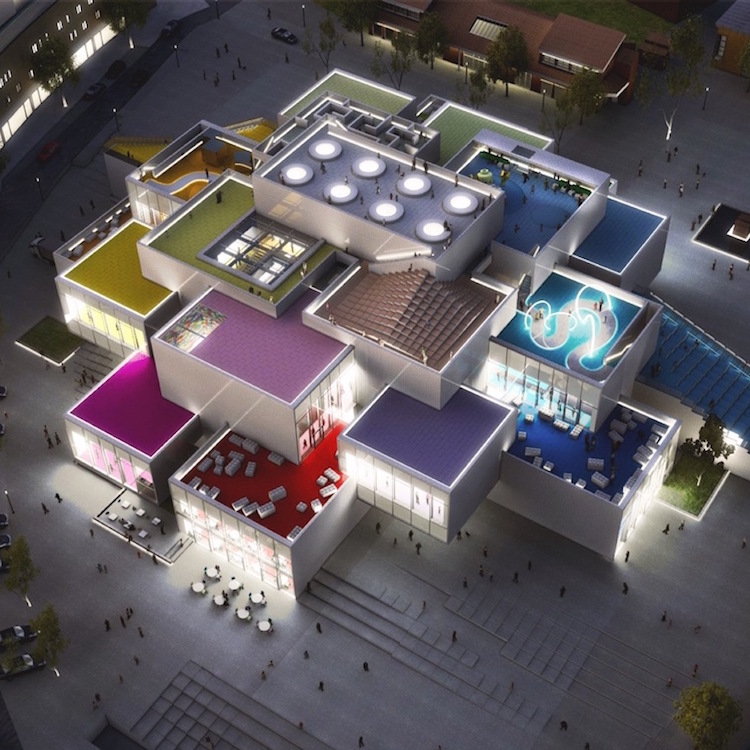Welcome back to NewsFile, your weekly round-up of interesting news from the worlds of contemporary ceramic art and contemporary ceramics. We’ll dive right in with Jeff Koons’ plagiarism case.
A French court has found that Koons’ porcelain work Naked copied late artist Jean-François Bauret’s photograph. Naked depicts two nude children standing atop a heart sprinkled with flowers.
Artforum writes, the judges decided there weren’t enough variations in Koons’s work from the photograph of the children in Bauret’s Enfants. They said the sculpture does “not prevent recognition and identification of the models.”

Jeff Koons LLC and the Center Pompidou were ordered to pay a $46,000 fine to the heirs of the photographer for “counterfeiting.”
BIG’s LEGO House Features Tile Facade

Bjarke Ingels Group’s LEGO house has topped out sparking excitement around the experience center’s forthcoming fall debut in Billund, Denmark. Inspired by the iconic plastic brick toy, the building features 21 white brick-shaped forms stacked on top of one another, according to ArchDaily
On the facade, textured clay tiles will give the building the illusion that it has been constructed from actual LEGO bricks.
Ingels tells DesignBoom, “the LEGO house will appear like a cloud of interlocking LEGO bricks that form spaces for exploration and exhibition for its visitors within.”
The LEGO experience center will provide an estimated 250,000 yearly guests with a variety of LEGO-themed activities within its 12,000 square meters, inviting visitors of all ages to play and unleash their creativity.


Grayson Perry’s Rival Brexit Pots

Ceramist Grayson Perry is working on two rival remain and leave vases as Britain approaches the one year anniversary of the historic Brexit vote. Each vase reflecting on competing narratives depicts the various faces of voters including an expectant mother, a soldier, even a Nigel Farage fan, the Guardian writes.
The 108cm-tall leave pot, and a symbolically smaller remain version, illustrate what Perry calls the “two great tribes of our time.” They are to be exhibited side by side to mark the first anniversary of Britain’s divisive vote to leave the EU.
Perry took to social media asking the public to share their thoughts and opinions on post-Brexit Britain ultimately finding voter models for his rival friezes. The chosen voters have not been officially unveiled as Perry continues to work on the pots as part of a forthcoming Channel 4 program called ‘What Britain Wants.’
The channel will broadcast an hour-long documentary tracking the process first thoughts to finished pots, and following Grayson as he visits the most pro-Brexit and pro-Remain parts of Britain.The two pots will form part of Grayson’s most important British solo exhibition, ‘The Most Popular Art Exhibition Ever’, which will be held at the Serpentine Gallery in June 2017.
Shipwreck Exhibition Highlights Vibrant Trade Partnership

Chinese porcelain wares from an ancient shipwreck will be shown in the US for the first time. The Asia Society in New York is presenting 76 extraordinarily well-preserved objects like white and blue ceramics and porcelain vessels salvaged from the wreck in its exhibition Secrets of the Sea: a Tang Shipwreck and Early Trade in Asia (New York, March 7 – June 4, 2017).
An Artsy editorial argues the objects demonstrate a strong trade alliance between China’s Tang Dynasty and their Middle Eastern partners.
It’s not entirely surprising that trade flourished between the two areas during this time. China’s Tang Dynasty and the Abbasid Caliphate in the Middle East were two notoriously vibrant and open cultures with cosmopolitan populations and vigorous trade networks

Furthermore, The Art Magazine writes Chinese artists adapted their wares to appeal to their trade partners.
The show also reveals how ancient Chinese artisans were influenced by the aesthetics of their trading partners, and tweaked their designs to appeal to foreign buyers. The oldest examples of Chinese blue and white ceramics, for example, made use of a Cobalt pigment imported from the Middle East and incorporated Middle Eastern motifs such as foliate designs.

New Ceramic Process May Render Kilns Obsolete

Researchers from ETH Zurich have developed a new way to manufacture ceramic products aimed at saving energy and lowering the world’s carbon footprint, the American Ceramics Society writes.
Traditional methods of making ceramics involves manufacturers firing materials at temperatures in excess of 1,832oF sucking up a lot of energy. With this new process, the scientists used a calcium carbonate nanopowder as the starting material and instead of firing it, they added a small amount of water and then compacted it, like sedimentary rock formation.
Sedimentary rock is formed from sediment that is compressed over millions of years through the pressure exerted by overlying deposits. This process turns calcium carbonate sediment into limestone with the help of the surrounding water.
After compaction, the final (tiny) ceramic material emerges. The scientists used small samples in their experiments, so producing larger pieces will require stronger hydraulics that can generate higher pressure and greater force. Even so, the process all occurs at room temperature significantly cutting down on energy consumption.

Do you love or loathe these news tidbits from the worlds of contemporary ceramics and contemporary ceramic art? Let us know in the comments.

Add your valued opinion to this post.